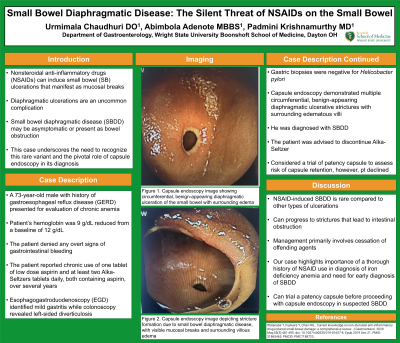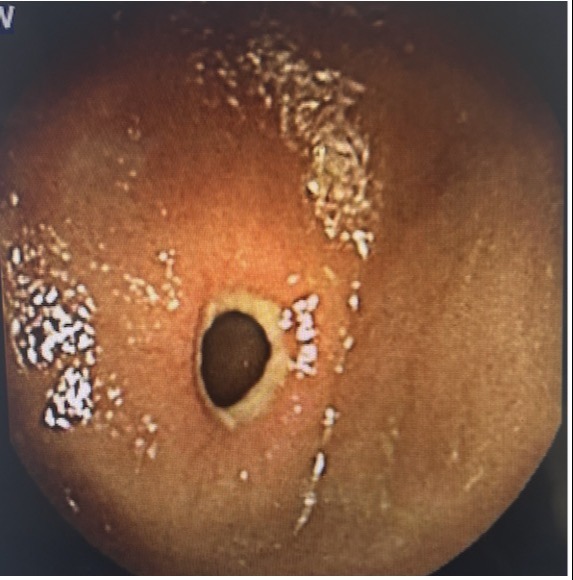Monday Poster Session
Category: Small Intestine
P3217 - Small Bowel Diaphragmatic Disease: The Silent Threat of NSAIDs on the Small Bowel
Monday, October 28, 2024
10:30 AM - 4:00 PM ET
Location: Exhibit Hall E

Has Audio

Urmimala Chaudhuri, DO
Wright State University
Centerville, OH
Presenting Author(s)
Urmimala Chaudhuri, DO1, Abimbola Adenote, MBBS2, Padmini Krishnamurthy, MD2
1Wright State University, Centerville, OH; 2Wright State University, Dayton, OH
Introduction: Nonsteroidal anti-inflammatory drugs (NSAIDs) can induce small bowel (SB) ulcers with various
morphologies, most commonly presenting as mucosal breaks. Diaphragmatic ulcerations are
rare, but they do occur. Small bowel diaphragmatic disease (SBDD) can be asymptomatic or
present with complications like bowel obstruction due to strictures. We present the case of a
patient with chronic anemia, found to have NSAID-induced SBDD of the distal ileum. This case
highlights the importance of recognizing this variant of NSAID-induced ulcer disease and the
role of capsule endoscopy in the diagnosis.
Case Description/Methods: A 73-year-old male with a history of gastroesophageal reflux disease (GERD), coronary artery
disease, and chronic lymphocytic leukemia was evaluated for chronic iron deficiency anemia.
The patient’s hemoglobin was 9 g/dL with a baseline around 12 g/dL. He denied overt signs of
gastrointestinal bleeding. He reported taking one low dose aspirin along with at least 2 Alka-
Seltzers, which also contain aspirin, daily for the last several years.
Esophagogastroduodenoscopy (EGD) revealed mild gastritis and colonoscopy revealed left-
sided diverticulosis. The terminal ileum was not intubated. Gastric biopsies were negative for
Helicobacter pylori. Capsule endoscopy revealed multiple, circumferential benign appearing
diaphragmatic ulcerative strictures with surrounding edematous villi in an area likely
corresponding to distal ileum. However, a Computer Tomography Enterography (CTE) was
normal. He was diagnosed with Small Bowel Diaphragmatic Disease and was counseled to
discontinue Alka-Seltzer. Patient declined a follow up capsule endoscopy.
Discussion: NSAID-induced SBDD is rare compared to other types ulcerations. It commonly progresses to
strictures that can lead to intestinal obstruction. As seen in our patient, these diaphragms are
usually multiple with ulcerated margins. Management primarily involves cessation of the
offending agents. Our case highlights the importance of a thorough history of NSAIDS use in the
diagnosis of iron deficiency anemia and emphasizes the need for early diagnosis of SBDD. Due
to the risk of capsule retention in these patients, it might be safer to trial a patency capsule
before proceeding with capsule endoscopy in suspected SBDD.

Disclosures:
Urmimala Chaudhuri, DO1, Abimbola Adenote, MBBS2, Padmini Krishnamurthy, MD2. P3217 - Small Bowel Diaphragmatic Disease: The Silent Threat of NSAIDs on the Small Bowel, ACG 2024 Annual Scientific Meeting Abstracts. Philadelphia, PA: American College of Gastroenterology.
1Wright State University, Centerville, OH; 2Wright State University, Dayton, OH
Introduction: Nonsteroidal anti-inflammatory drugs (NSAIDs) can induce small bowel (SB) ulcers with various
morphologies, most commonly presenting as mucosal breaks. Diaphragmatic ulcerations are
rare, but they do occur. Small bowel diaphragmatic disease (SBDD) can be asymptomatic or
present with complications like bowel obstruction due to strictures. We present the case of a
patient with chronic anemia, found to have NSAID-induced SBDD of the distal ileum. This case
highlights the importance of recognizing this variant of NSAID-induced ulcer disease and the
role of capsule endoscopy in the diagnosis.
Case Description/Methods: A 73-year-old male with a history of gastroesophageal reflux disease (GERD), coronary artery
disease, and chronic lymphocytic leukemia was evaluated for chronic iron deficiency anemia.
The patient’s hemoglobin was 9 g/dL with a baseline around 12 g/dL. He denied overt signs of
gastrointestinal bleeding. He reported taking one low dose aspirin along with at least 2 Alka-
Seltzers, which also contain aspirin, daily for the last several years.
Esophagogastroduodenoscopy (EGD) revealed mild gastritis and colonoscopy revealed left-
sided diverticulosis. The terminal ileum was not intubated. Gastric biopsies were negative for
Helicobacter pylori. Capsule endoscopy revealed multiple, circumferential benign appearing
diaphragmatic ulcerative strictures with surrounding edematous villi in an area likely
corresponding to distal ileum. However, a Computer Tomography Enterography (CTE) was
normal. He was diagnosed with Small Bowel Diaphragmatic Disease and was counseled to
discontinue Alka-Seltzer. Patient declined a follow up capsule endoscopy.
Discussion: NSAID-induced SBDD is rare compared to other types ulcerations. It commonly progresses to
strictures that can lead to intestinal obstruction. As seen in our patient, these diaphragms are
usually multiple with ulcerated margins. Management primarily involves cessation of the
offending agents. Our case highlights the importance of a thorough history of NSAIDS use in the
diagnosis of iron deficiency anemia and emphasizes the need for early diagnosis of SBDD. Due
to the risk of capsule retention in these patients, it might be safer to trial a patency capsule
before proceeding with capsule endoscopy in suspected SBDD.

Figure: Figure 1. NSAID-induced small bowel ulcer
Disclosures:
Urmimala Chaudhuri indicated no relevant financial relationships.
Abimbola Adenote indicated no relevant financial relationships.
Padmini Krishnamurthy indicated no relevant financial relationships.
Urmimala Chaudhuri, DO1, Abimbola Adenote, MBBS2, Padmini Krishnamurthy, MD2. P3217 - Small Bowel Diaphragmatic Disease: The Silent Threat of NSAIDs on the Small Bowel, ACG 2024 Annual Scientific Meeting Abstracts. Philadelphia, PA: American College of Gastroenterology.
